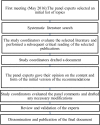Preventing the Complications Associated with the Use of Dermal Fillers in Facial Aesthetic Procedures: An Expert Group Consensus Report
- PMID: 28411354
- PMCID: PMC5440530
- DOI: 10.1007/s00266-017-0798-y
Preventing the Complications Associated with the Use of Dermal Fillers in Facial Aesthetic Procedures: An Expert Group Consensus Report
Abstract
Background: The use of dermal fillers in minimally invasive facial aesthetic procedures has become increasingly popular of late, yet as the indications and the number of procedures performed increase, the number of complications is also likely to increase. Paying special attention to specific patient characteristics and to the technique used can do much to avoid these complications. Indeed, a well-trained physician can also minimize the impact of such problems when they do occur.
Methods: A multidisciplinary group of experts in aesthetic treatments reviewed the main factors associated with the complications that arise when using dermal fillers. A search of English, French and Spanish language articles in PubMed was performed using the terms "complications" OR "soft filler complications" OR "injectable complications" AND "dermal fillers". An initial document was drafted that reflected the complications identified and recommendations as to how they should be handled. This document was then reviewed and modified by the expert panel, until a final text was agreed upon and validated.
Results: The panel addressed consensus recommendations about the preparation, the procedure and the post-procedural care. The panel considered it crucial to obtain an accurate medical history to prevent potential complications. An additional clinical assessment, including standardized photography, is also crucial to evaluate the outcomes and prevent potential complications. Furthermore, the state of the operating theatre, the patient's health status and the preparation of the skin are critical to prevent superficial soft tissue infections. Finally, selecting the appropriate technique, based on the physician's experience, as well as the characteristics of the patient and filler, helps to ensure successful outcomes and limits the complications.
Conclusions: This consensus document provides key elements to help clinicians who are starting to use dermal fillers to employ standard procedures and to understand how best to prevent potential complications of the treatment.
Level of evidence v: This journal requires that authors assign a level of evidence to each article. For a full description of these Evidence-Based Medicine ratings, please refer to the Table of Contents or the online Instructions to Authors www.springer.com/00266 .
Keywords: Aesthetic procedures; Complications; Dermal fillers; Prevention.
Conflict of interest statement
None.
Figures





Similar articles
-
Concomitant Use of Hyaluronic Acid and Laser in Facial Rejuvenation.Aesthetic Plast Surg. 2019 Aug;43(4):1061-1070. doi: 10.1007/s00266-019-01393-7. Epub 2019 May 9. Aesthetic Plast Surg. 2019. PMID: 31073742 Free PMC article. Review.
-
Treatment of Soft Tissue Filler Complications: Expert Consensus Recommendations.Aesthetic Plast Surg. 2018 Apr;42(2):498-510. doi: 10.1007/s00266-017-1063-0. Epub 2018 Jan 5. Aesthetic Plast Surg. 2018. PMID: 29305643 Free PMC article. Review.
-
Permanent Facial Fillers: Addressing Complications and Advancing Solutions.Aesthetic Plast Surg. 2025 Apr;49(7):2137-2139. doi: 10.1007/s00266-024-04104-z. Epub 2024 May 8. Aesthetic Plast Surg. 2025. PMID: 38720100 Review.
-
Brazilian Consensus Recommendation on the Use of Polymethylmethacrylate Filler in Facial and Corporal Aesthetics.Aesthetic Plast Surg. 2018 Oct;42(5):1244-1251. doi: 10.1007/s00266-018-1167-1. Epub 2018 Jun 5. Aesthetic Plast Surg. 2018. PMID: 29872906 Review.
-
Nonsurgical Chin Augmentation Using Hyaluronic Acid: A Systematic Review of Technique, Satisfaction, and Complications.Aesthetic Plast Surg. 2024 Jan;48(1):52-54. doi: 10.1007/s00266-023-03686-4. Epub 2023 Oct 9. Aesthetic Plast Surg. 2024. PMID: 37814037
Cited by
-
Recommendations for the use of corrective makeup after dermatological procedures.J Cosmet Dermatol. 2022 Apr;21(4):1554-1558. doi: 10.1111/jocd.14248. Epub 2021 Jun 18. J Cosmet Dermatol. 2022. PMID: 34021952 Free PMC article.
-
The impact of lifestyle upon the probability of late bacterial infection after soft-tissue filler augmentation.Infect Drug Resist. 2019 Apr 23;12:855-863. doi: 10.2147/IDR.S200357. eCollection 2019. Infect Drug Resist. 2019. PMID: 31118696 Free PMC article.
-
Concomitant Use of Hyaluronic Acid and Laser in Facial Rejuvenation.Aesthetic Plast Surg. 2019 Aug;43(4):1061-1070. doi: 10.1007/s00266-019-01393-7. Epub 2019 May 9. Aesthetic Plast Surg. 2019. PMID: 31073742 Free PMC article. Review.
-
Nonsurgical Approach to Treat Post-Rhinoplasty Vascular Complication With Hyaluronic Acid Injection.J Cosmet Dermatol. 2025 Jul;24(7):e70294. doi: 10.1111/jocd.70294. J Cosmet Dermatol. 2025. PMID: 40586313 Free PMC article.
-
Facial Contouring by Using Dermal Fillers and Botulinum Toxin A: A Practical Approach.Aesthetic Plast Surg. 2019 Jun;43(3):793-802. doi: 10.1007/s00266-019-01361-1. Epub 2019 Apr 5. Aesthetic Plast Surg. 2019. PMID: 30953112 Free PMC article.
References
-
- 2012 Plastic Surgery Procedural Statistics (2012) http://www.plasticsurgery.org/Documents/news-resources/statistics/2012-P.... Accessed on 13 June 16
Publication types
MeSH terms
Substances
LinkOut - more resources
Full Text Sources
Other Literature Sources
Medical
Research Materials

